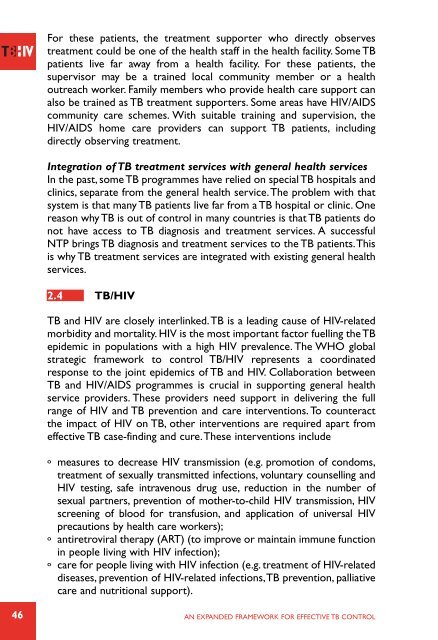TB/HIV: a clinical manual - libdoc.who.int - World Health Organization
TB/HIV: a clinical manual - libdoc.who.int - World Health Organization
TB/HIV: a clinical manual - libdoc.who.int - World Health Organization
Create successful ePaper yourself
Turn your PDF publications into a flip-book with our unique Google optimized e-Paper software.
For these patients, the treatment supporter <strong>who</strong> directly observestreatment could be one of the health staff in the health facility. Some <strong>TB</strong>patients live far away from a health facility. For these patients, thesupervisor may be a trained local community member or a healthoutreach worker. Family members <strong>who</strong> provide health care support canalso be trained as <strong>TB</strong> treatment supporters. Some areas have <strong>HIV</strong>/AIDScommunity care schemes. With suitable training and supervision, the<strong>HIV</strong>/AIDS home care providers can support <strong>TB</strong> patients, includingdirectly observing treatment.Integration of <strong>TB</strong> treatment services with general health servicesIn the past, some <strong>TB</strong> programmes have relied on special <strong>TB</strong> hospitals andclinics, separate from the general health service.The problem with thatsystem is that many <strong>TB</strong> patients live far from a <strong>TB</strong> hospital or clinic. Onereason why <strong>TB</strong> is out of control in many countries is that <strong>TB</strong> patients donot have access to <strong>TB</strong> diagnosis and treatment services. A successfulNTP brings <strong>TB</strong> diagnosis and treatment services to the <strong>TB</strong> patients.Thisis why <strong>TB</strong> treatment services are <strong>int</strong>egrated with existing general healthservices.2.4 <strong>TB</strong>/<strong>HIV</strong><strong>TB</strong> and <strong>HIV</strong> are closely <strong>int</strong>erlinked.<strong>TB</strong> is a leading cause of <strong>HIV</strong>-relatedmorbidity and mortality. <strong>HIV</strong> is the most important factor fuelling the <strong>TB</strong>epidemic in populations with a high <strong>HIV</strong> prevalence. The WHO globalstrategic framework to control <strong>TB</strong>/<strong>HIV</strong> represents a coordinatedresponse to the jo<strong>int</strong> epidemics of <strong>TB</strong> and <strong>HIV</strong>. Collaboration between<strong>TB</strong> and <strong>HIV</strong>/AIDS programmes is crucial in supporting general healthservice providers. These providers need support in delivering the fullrange of <strong>HIV</strong> and <strong>TB</strong> prevention and care <strong>int</strong>erventions. To counteractthe impact of <strong>HIV</strong> on <strong>TB</strong>, other <strong>int</strong>erventions are required apart fromeffective <strong>TB</strong> case-finding and cure.These <strong>int</strong>erventions includeº measures to decrease <strong>HIV</strong> transmission (e.g. promotion of condoms,treatment of sexually transmitted infections, voluntary counselling and<strong>HIV</strong> testing, safe <strong>int</strong>ravenous drug use, reduction in the number ofsexual partners, prevention of mother-to-child <strong>HIV</strong> transmission, <strong>HIV</strong>screening of blood for transfusion, and application of universal <strong>HIV</strong>precautions by health care workers);º antiretroviral therapy (ART) (to improve or ma<strong>int</strong>ain immune functionin people living with <strong>HIV</strong> infection);º care for people living with <strong>HIV</strong> infection (e.g. treatment of <strong>HIV</strong>-relateddiseases, prevention of <strong>HIV</strong>-related infections,<strong>TB</strong> prevention, palliativecare and nutritional support).46AN EXPANDED FRAMEWORK FOR EFFECTIVE <strong>TB</strong> CONTROL
















